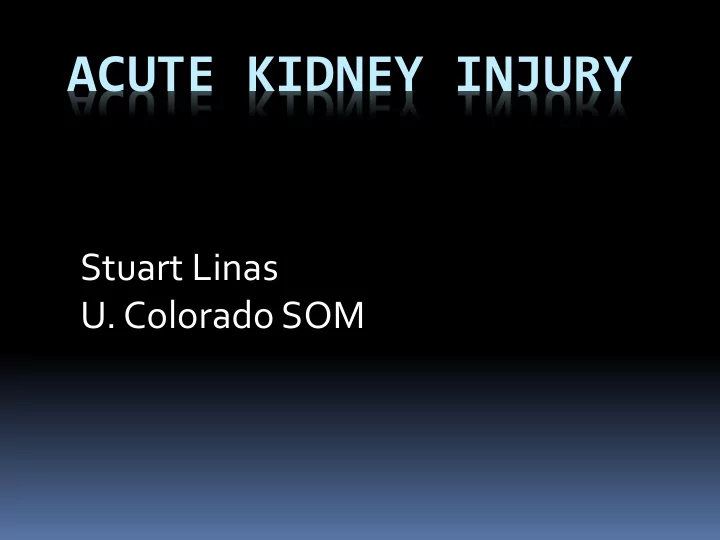

Methods Patients undergoing PCI RIPC: cycles of inflation/deflation ( 3o sec each x 4)of stent balloon during PCI (N 111) Sham procedure (N109) Primary Endpoint AKI at 96 hrs after PCI 0.5 mg/dl increase in creatinine or 25% increase in creatinine
50% reduction in AKI with RIPC
More Results 30 day rate of death or rehospitalization: Control 22% RIPC 12%
Conclusions RIMC during PCI is a simple and effective procedure to prevent AKI
Practical Implications Of Preconditioning Why not perform in setting where AKI known risk? Contrast PCI AAA Repair Other
Therapy: What is the best type of renal replacement therapy: Intermittent Hemodialysis (IHD) or Continuous Venovenous hemofiltration (CVVH)?
Options: Ultrafiltration (pressure- dependent convection) vs. Dialysis (concentration-dependent diffusion) BF (ml/min) UF (ml/hr) Dialysate Replacement Fluid (ml/hr) SCUF 100 50 No No SLED 100 0 Yes No CVVH 200 2000 No Up to 2000 CVVHDF 200 2000 Yes Up to 2000 IHD 400 0-1000 Yes 0-1000
JAMA 299 793 2008 203
Background and Methods Review of randomized controlled trials (n=30) and prospective cohort studies (n=8) of dialytic therapy in AKI
Conclusions Intermittent and continuous therapy lead to the same outcomes
What is the correct ‘amount’ of dialysis required?
INTENSITIES OF RENAL REPLACEMENT THERAPY IN ACUTE KIDNEY INJURY: A SYSTEMATIC REVIEW AND META-ANALYSIS LAMBERS HEERSPINK,*† TOSHIHARU NINOMIYA,* MARTIN GALLAGHER,* RINALDO BELLOMO,‡ JOHN MYBURGH,*§ SIMON FINFER,* PAUL M. PALEVSKY,¶** JOHN A. KELLUM,†† VLADO PERKOVIC,* AND ALAN CASS* CJASN 5 956 2010
Background and Objectives Systematic review and meta-analysis of 8 large trials 3841 patients 35-48 ml/kg/hr defined as more intense
Conclusions Higher intensity RRT does not reduce mortality or improve renal recovery in total cohort or subgroups
SPECIFIC CONDITIONS: CARDIORENAL SYNDROME (CRS)
CRS: Classification Acute CRS (Type 1, acute worsening of heart function leading to kidney injury) Chronic CRS (Type 2, chronic heart disease leading to kidney injury) Acute reno-cardiac syndrome (Type 3, acute kidney injury leading to heart dysfunction) Chronic CRS (Type 4, CKD leading to cardiac dysfunction) Secondary CRS (Type 5, systemic diseases resulting in heart and kidney injury)
Diuretic (Furosemide) Therapies In Type 1 CRS DOSE Trial Prospective randomized, blinded trial Comparison of: IV bolus q 12hrs Continuous infusion (low dose-prior oral dose) Continuous infusion (high dose-2.5x prior oral dose) NEJM 364 801 2011
Renal function about same with continuous vs continuous therapy BUT clearly worse with high dose continuous therapy
Composite Endpoints: No differences between bolus and continuous therapy or low vs high dose continuous therapy
Conclusions In Acute CRS (Type 1) no advantages of continuous vs bolus diuretic therapy High dose continuous therapy is ‘bad’ for the kidney!
What about Ultrafiltration compared to diuretic therapy?
NEJM 267 2296 2012 ICU 12
Background: CARESS-HF (Cardiorenal Rescue Study in Acute Decompensated Heart Failure) Acute Cardiorenal syndrome: worsening renal function in patients with acute decompensated heart failure Controversy regarding the role of ultrafiltration therapy compared to diuretics
Methods Randomized, prospective comparison of UF to aggressive diuretic therapy 188 patients with acute cardiorenal syndrome Baseline creatinine 2 mg/dl Primary EP: combination of change in creatinine and weight—all results driven by change in creatinine UF: 200 ml/hr—4-5l/d Diuretics: 4-6l/d urine output
At comparable weight loss, UF associated with greater increases in serum creatinine
Conclusions Diuretic therapy was safer than UF in treating patients with the Acute Cardiorenal Syndrome Fewer adverse events with diuretics as well
But…… Serum creatinine is a poor endpoint marker for eGFR since it may reflect differences in convective removal as well as renal function ‘Who cares’ if there is a transient increase in creatinine if returns to baseline after UF discontinued? What about the readmission rate as a more helpful endpoint?
CRS: Therapeutic Conclusions Aggressive diuretic therapies not associated with benefits and may injure the kidney UF therapies should be reserved for diuretic- resistant patients
Contrast-Induced Nephropathy (CIN)
Recommend
More recommend